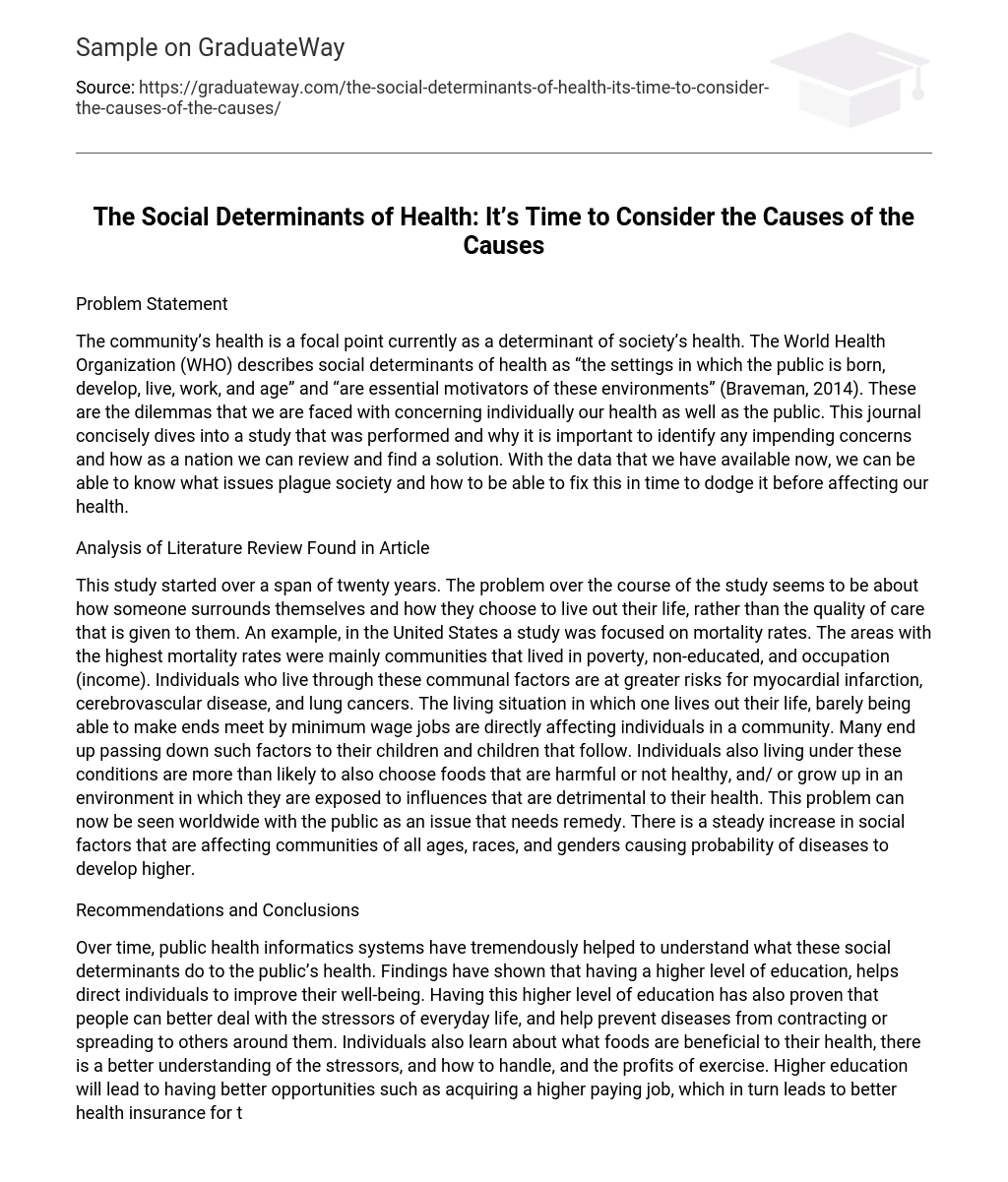Problem Statement
The community’s health is a focal point currently as a determinant of society’s health. The World Health Organization (WHO) describes social determinants of health as “the settings in which the public is born, develop, live, work, and age” and “are essential motivators of these environments” (Braveman, 2014). These are the dilemmas that we are faced with concerning individually our health as well as the public. This journal concisely dives into a study that was performed and why it is important to identify any impending concerns and how as a nation we can review and find a solution. With the data that we have available now, we can be able to know what issues plague society and how to be able to fix this in time to dodge it before affecting our health.
Analysis of Literature Review Found in Article
This study started over a span of twenty years. The problem over the course of the study seems to be about how someone surrounds themselves and how they choose to live out their life, rather than the quality of care that is given to them. An example, in the United States a study was focused on mortality rates. The areas with the highest mortality rates were mainly communities that lived in poverty, non-educated, and occupation (income). Individuals who live through these communal factors are at greater risks for myocardial infarction, cerebrovascular disease, and lung cancers. The living situation in which one lives out their life, barely being able to make ends meet by minimum wage jobs are directly affecting individuals in a community. Many end up passing down such factors to their children and children that follow. Individuals also living under these conditions are more than likely to also choose foods that are harmful or not healthy, and/ or grow up in an environment in which they are exposed to influences that are detrimental to their health. This problem can now be seen worldwide with the public as an issue that needs remedy. There is a steady increase in social factors that are affecting communities of all ages, races, and genders causing probability of diseases to develop higher.
Recommendations and Conclusions
Over time, public health informatics systems have tremendously helped to understand what these social determinants do to the public’s health. Findings have shown that having a higher level of education, helps direct individuals to improve their well-being. Having this higher level of education has also proven that people can better deal with the stressors of everyday life, and help prevent diseases from contracting or spreading to others around them. Individuals also learn about what foods are beneficial to their health, there is a better understanding of the stressors, and how to handle, and the profits of exercise. Higher education will lead to having better opportunities such as acquiring a higher paying job, which in turn leads to better health insurance for the individual and their families, as well as regular doctor visits for a healthier life style. With a higher profession the chances of buying healthier foods is also higher because the household income is higher. Finally, having a higher level of education improves ones mental and social processes. Education teaches many how to interact with others and network. Together many communities can come together and help better their community with inputs on improving by ways of activities or other things. Education has been a focal point in this study and has shown how greatly it leads to an improvement of behaviors amongst others as well as respect other.
Applications of This Article
We can conclude that social determinants of health are greatly influenced by social factors and puts communities at risk. Education is a fundamental element that leads communities to better themselves. There are other factors that affect the overall health of individuals like urban areas, scarcity, and the conditions in which people are raised. This article states it is best to be able to come up with a better education system in order to educate individuals on how much things in their environment really affects the rest of the population. Household income can be a determinant of health, but it is not the only factor that influences one’s health. More education for the community on how to take better care of themselves would be the answer.
As a community it is important for one to take care of themselves as they represent a piece to the public. In other words, if one person is not healthy, then the rest of the public suffers. We must maintain the public informed as well as educated in order to reduce many diseases or conditions that take toll on our health overtime. We must maintain our streets clean and crime free through providing education on health maintenance as a community. This article’s purpose serves just that, in order to bring communities together and help keep the well-beings of other up to par and maintain stressors, and diseases which are detrimental to the health of a person at a minimum. There are not enough health care workers trained in social work that can express that it is more than just running tests, its more about our environment and how we live. If we live in an urban area, it is harder to overcome these problems. If one does not live in a good neighborhood, how can one expect to overcome these factors? It’s important to make these changes now so that our children after us grow up in a healthy environment and their kids can follow after.What is your CRITICAL ANALYSIS of this article?
References
- Braveman, P., & Gottlieb, L. (2014). The Social Determinants of Health: It’s Time to
- Consider the Causes of the Causes. The Social Determinants of Health: It’s Time to Consider the Causes of the Causes, 129(2), 19–31. doi: 10.1177/00333549141291S206





